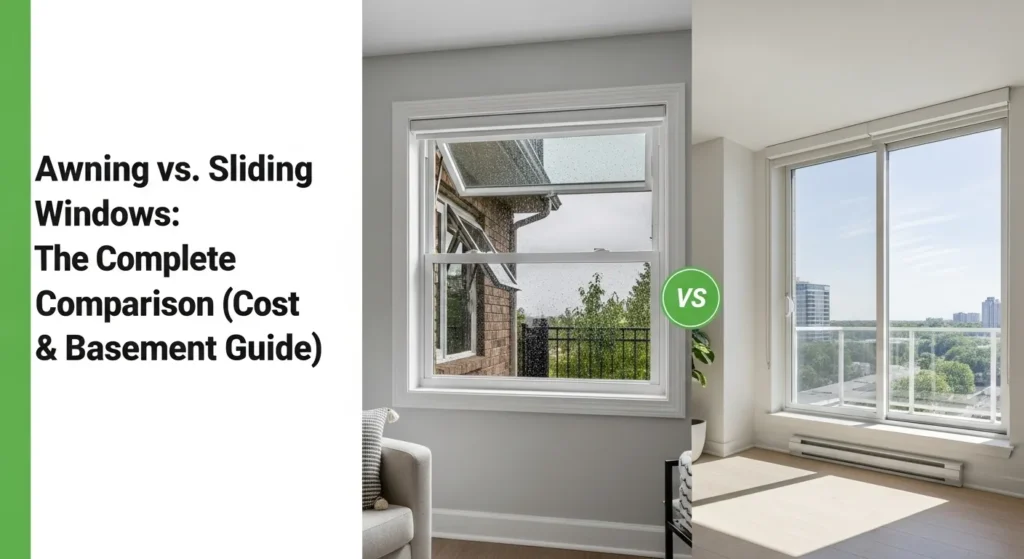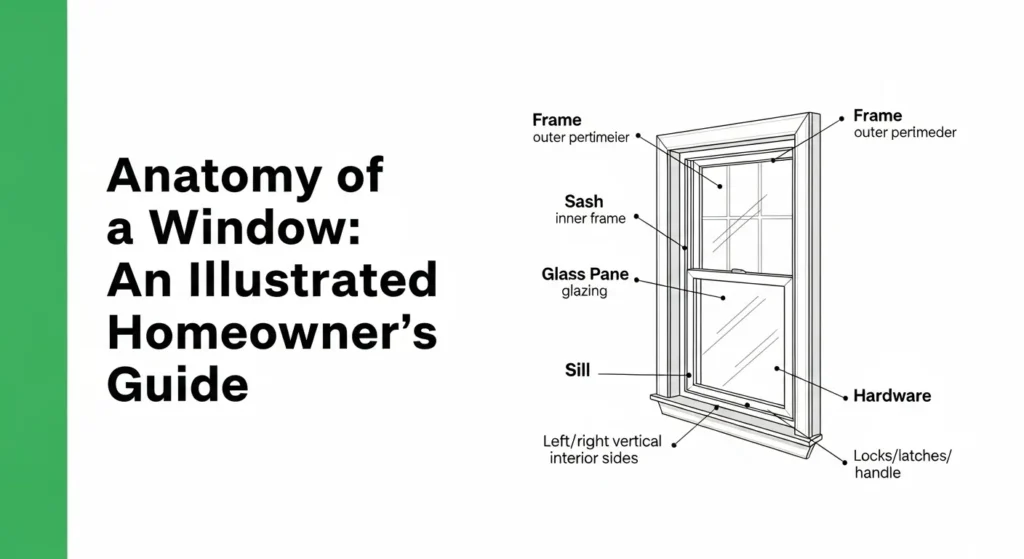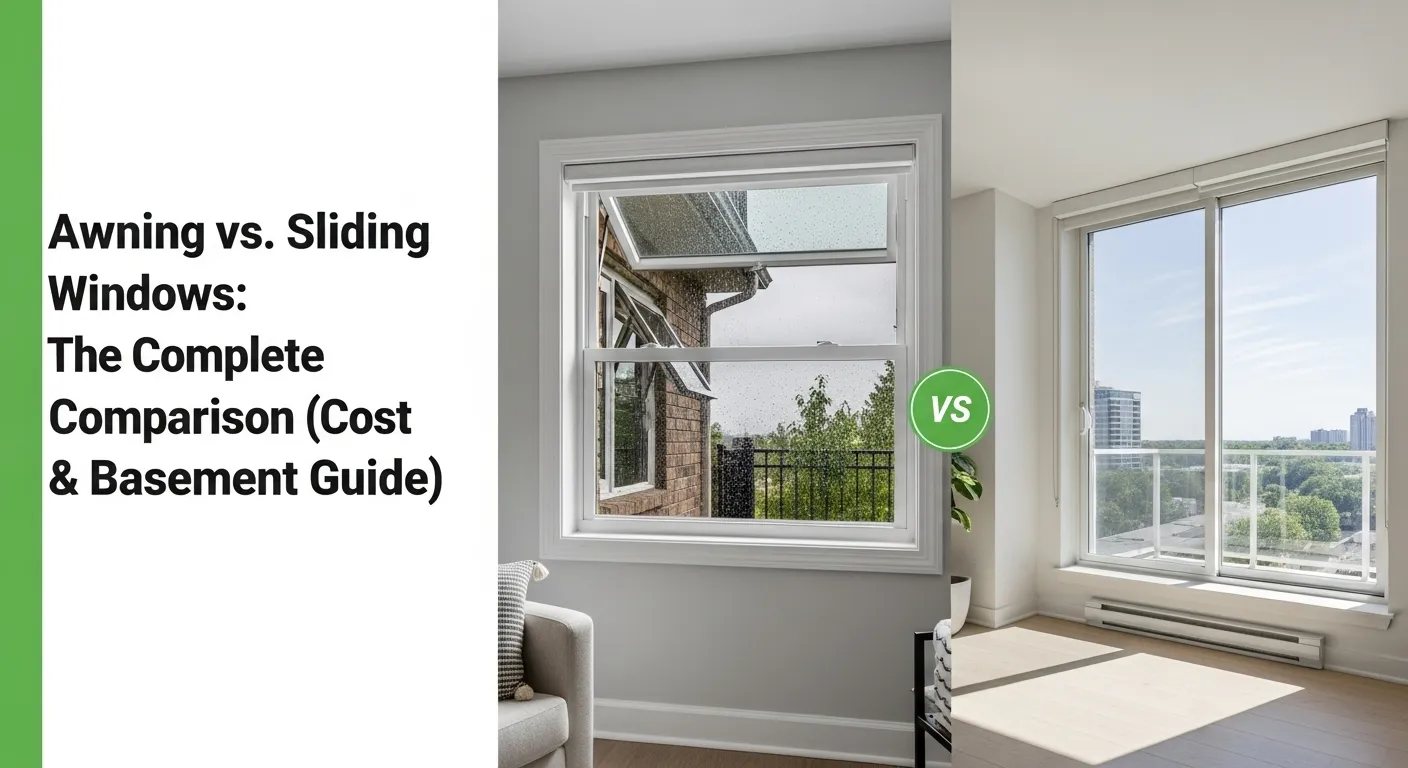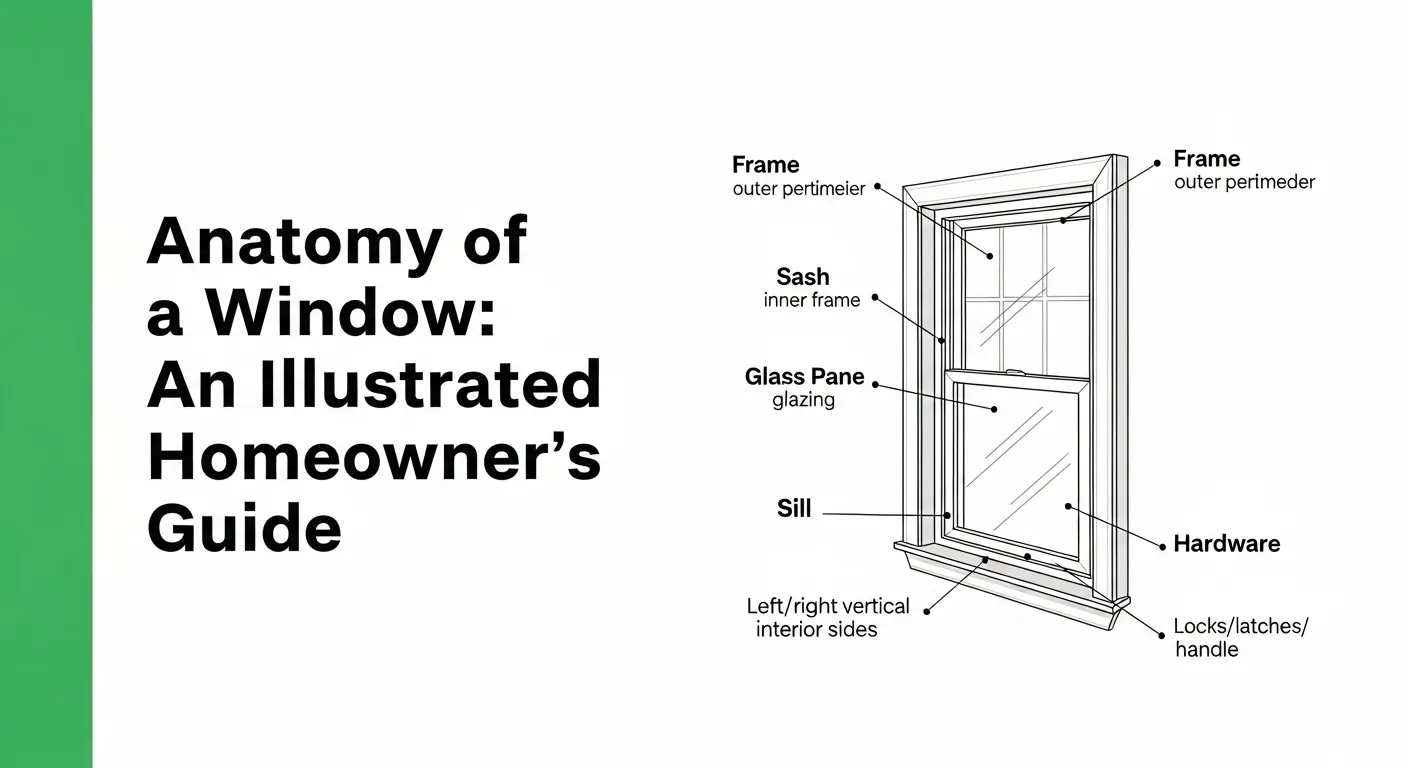Wish your windows offered a clearer view? Cleaning single-hung windows, whether they tilt-in for easy access or are non-tilt, is manageable with the right approach. Dirt, streaks, and grime can obstruct your view and make your home look less appealing.
This guide provides clear, step-by-step instructions for cleaning both tilt-in and non-tilt single-hung windows, covering interior and exterior surfaces, frames, tracks, and screens for sparkling results.
First, a quick refresher: What is a single-hung window? It features a fixed top sash and a bottom sash that slides vertically.
Why Clean Your Windows Regularly?
- Clear Views: Enjoy unobstructed scenery outside.
- Curb Appeal: Clean windows significantly enhance your home’s appearance.
- Longevity: Removing dirt prevents buildup that can hinder operation or damage seals over time. (See more on window maintenance.).
- Light: Clean glass allows more natural light into your home.
Gather Your Cleaning Supplies
Having the right tools makes the job easier and more effective:
- Microfiber Cloths: Several clean, lint-free cloths are essential for washing and drying/buffing.
- Cleaning Solution:
- Option 1: Simple mix of warm water and a few drops of mild dish soap.
- Option 2: Mix equal parts white vinegar and warm water in a spray bottle.
- Avoid ammonia or alcohol-based cleaners which can streak or damage tints/frames.
- Bucket(s): One for cleaning solution, optionally a second for rinsing cloths.
- Squeegee (Optional but Recommended): Choose one with a smooth, flexible rubber blade, sized appropriately for your window panes.
- Soft Brush / Vacuum: For removing loose dirt from tracks and frames.
- Old Towels/Rags: To place below the window and catch drips.
- Step Stool / Ladder (If Needed): Use with extreme caution for reaching high areas.
- Gloves (Optional): To protect hands and hold better.
Prepare the Window Area
A few minutes of prep saves time and protects your home:
- Clear the Space: Move furniture, plants, and decor away from the window, inside and out.
- Remove Window Treatments: Take down curtains, blinds, and shades.
- Initial Dusting: Use a dry microfiber cloth or vacuum brush attachment to remove loose dust, cobwebs, and debris from the window frame, sash, sill, and tracks. Open the bottom sash partway to access the lower tracks.
Cleaning Tilt-In Single-Hung Windows
This is the easiest type, allowing you to clean both sides of the bottom sash from inside.
Cleaning Tilt-In Single-Hung Windows
Enjoy the ease of washing both sides from indoors.
1 Tilt the Bottom Sash Inward
Follow these steps to safely tilt your bottom window sash inward:
- Unlock: Ensure the window lock is disengaged.
- Raise Slightly: Lift the bottom sash 3-6 inches.
- Find Latches: Locate the tilt latches (tabs or levers) on the top edge of the bottom sash frame.
- Engage Latches: Simultaneously slide/press both latches inwards.
- Tilt Gently: Carefully pull the top of the sash towards you, letting it rest securely (often on safety stops or the sill).
2 Clean the Exterior Glass (Now Facing In)
Now that the exterior is accessible, clean it with these steps:
- Apply Cleaner: Spray your solution onto a clean microfiber cloth (not directly on the glass).
- Wash: Wipe the glass thoroughly, typically top-to-bottom or side-to-side.
- Squeegee (Optional): Starting at the top, pull the squeegee down in smooth, overlapping strokes. Wipe the blade clean after each stroke.
- Dry/Buff: Use a separate, clean, dry microfiber cloth to wipe edges and buff the glass for a streak-free shine.
3 Clean the Interior Glass
After cleaning the exterior surface, proceed to the interior glass:
- Use the same wash and dry/buff method on the interior side of the bottom sash glass.
- Make sure to clean the edges and corners where dirt often accumulates.
- For best results, use a lint-free microfiber cloth.
- Work in sections to ensure a thorough clean.
4 Return Sash to Position
Once cleaning is complete, secure the window properly:
- Carefully tilt the sash back up towards the frame until the tilt latches click securely back into place on both sides.
- Ensure both sides click into position simultaneously.
- Lower the sash completely and lock the window.
- Test the window by gently trying to raise it while locked to verify security.
5 Clean the Fixed Top Sash (Interior)
Finish by cleaning the fixed top portion:
- Clean the inside surface of the fixed top sash using the same wash and dry method.
- Pay special attention to the meeting rail where the two sashes come together, as dirt often accumulates here.
- For the exterior of the fixed top sash, you’ll typically need outside access.
- Consider using an extension tool with a microfiber attachment for better reach.
Note: Cleaning the exterior of the fixed top sash on a tilt-in window usually still requires outside access.
1. Tilt the Bottom Sash Inward:
- Unlock: Ensure the window lock is disengaged.
- Raise Slightly: Lift the bottom sash 3-6 inches.
- Find Latches: Locate the tilt latches (tabs or levers) on the top edge of the bottom sash frame.
- Engage Latches: Simultaneously slide/press both latches inwards.
- Tilt Gently: Carefully pull the top of the sash towards you, letting it rest securely (often on safety stops or the sill).
2. Clean the Exterior Glass (Now Facing In):
- Apply Cleaner: Spray your solution onto a clean microfiber cloth (not directly on the glass).
- Wash: Wipe the glass thoroughly, typically top-to-bottom or side-to-side.
- Squeegee (Optional): Starting at the top, pull the squeegee down in smooth, overlapping strokes. Wipe the blade clean after each stroke.
- Dry/Buff: Use a separate, clean, dry microfiber cloth to wipe edges and buff the glass for a streak-free shine.
3. Clean the Interior Glass:
- Use the same wash and dry/buff method on the interior side of the bottom sash glass.
4. Return Sash to Position:
- Carefully tilt the sash back up towards the frame until the tilt latches click securely back into place on both sides.
- Lower the sash completely and lock the window.
5. Clean the Fixed Top Sash (Interior):
- Clean the inside surface of the fixed top sash using the same wash and dry method.
*(Cleaning the *exterior* of the fixed top sash on a tilt-in window usually still requires outside access – see below).*
Cleaning Non-Tilt Single-Hung Windows
These require different approaches, especially for the exterior surfaces.
Cleaning Non-Tilt Single-Hung Windows
These require different approaches, especially for the exterior surfaces.
1 Clean the Bottom Sash (Interior)
The interior surface of the bottom sash is the easiest to clean:
- Prepare your cleaning solution and gather microfiber cloths.
- Spray the solution onto your cloth (not directly on the glass).
- Wipe the glass thoroughly, typically in a top-to-bottom or side-to-side pattern.
- Dry with a clean microfiber cloth to prevent streaking.
- Pay special attention to corners and edges where dirt accumulates.
2 Clean the Bottom Sash (Exterior)
For the exterior surface of the bottom sash:
- Raise Sash: Slide the bottom sash all the way up to create access space.
- Reach Through: Carefully reach through the opening to wash the exterior surface.
- Use the same cleaning technique as before – spray on cloth, wipe thoroughly, and dry.
- For windows with screens, you’ll need to remove the screen first (usually from inside).
Safety First
Be mindful of your balance and security when reaching out. Never lean too far out of a window, especially on upper floors.
3 Clean the Fixed Top Sash (Interior)
The interior of the top sash is straightforward to clean:
- Lower the bottom sash if it’s still raised from the previous step.
- Use the same wash and dry/buff method as with other interior surfaces.
- Pay special attention to the meeting rail (where top and bottom sashes meet) as dirt often accumulates there.
- For tall windows, use a step stool if needed, ensuring it’s stable and secure.
4 Clean the Fixed Top Sash (Exterior – Ground Floor)
For ground floor windows, cleaning the exterior of the top sash is relatively easy:
- From outside, use the same cleaning method as for interior surfaces.
- For better results, use a squeegee after washing.
- Work on a cloudy day to prevent the cleaning solution from drying too quickly.
- If screens are present, remove them first and clean separately with a hose or in a tub.
5 Clean the Fixed Top Sash (Exterior – Upper Floors)
For upper floor windows, you have several options:
- Extendable Poles: Use telescoping poles with scrubber and squeegee attachments. Work methodically in a S-pattern for best results.
- Sash Removal (if possible): Some windows allow the bottom sash to be removed, providing better access to the exterior top sash.
- Ladder Access: If using a ladder, ensure it’s properly secured and follow all safety protocols.
- Professional Help: For high or difficult-to-reach windows, hiring professionals is often the safest and most effective option.
Safety Warning
Never risk your safety for clean windows. For upper floors, professional window cleaners have the proper equipment and training to do the job safely.
1. Clean the Bottom Sash (Interior):
- Wash and dry the inside glass surface as usual.
2. Clean the Bottom Sash (Exterior):
- Raise Sash: Slide the bottom sash all the way up.
- Reach Through: Carefully reach through the opening to wash and dry the exterior surface of the bottom sash glass. Be mindful of safety if reaching out significantly.
3. Clean the Fixed Top Sash (Interior):
- Wash and dry the inside glass surface as usual.
4. Clean the Fixed Top Sash (Exterior – The Challenge):
- Ground Floor: Easily cleaned from outside using the method below (“Cleaning from the Outside“).
- Upper Floors (Options):
- Ladder Access (Use Extreme Caution): If safe and comfortable using a ladder, you can access the window directly. Always follow strict ladder safety protocols and have a spotter if possible.
- Extendable Poles: Use telescoping poles with cleaning (scrubber/microfiber) and squeegee attachments. Practice your technique for best results.
- Sash Removal (Possible Option): Some non-tilt windows allow the bottom sash to be removed entirely (via takeout clips or specific maneuvers), which may provide better inside access to the outside of the fixed top sash. See our guide on removing single-hung sashes for relevant techniques, but assess your specific window first.
- Hire Professionals: For high or difficult-to-reach windows, professional window cleaners have the equipment and expertise for safe, efficient cleaning. This is often the best choice for upper floors.
Cleaning Windows from the Outside (Ground Floor / Accessible)
This method works well for easily reachable windows.
- Pre-Rinse: Gently rinse the window and frame with a garden hose (low pressure – avoid pressure washers) to remove loose dirt.
- Wash: Use a bucket of your cleaning solution and a soft microfiber wash mitt or sponge on a pole (if needed) to scrub the glass and frame.
- Rinse Thoroughly: Hose down the window again to remove all soap residue.
- Squeegee Dry: Use a squeegee, starting from the top, pulling down in smooth, overlapping strokes. Wipe the blade clean between strokes.
- Wipe Edges: Use a clean microfiber cloth to dry the frame and edges of the glass.
Don’t Forget the Screens!
Clean screens improve airflow and visibility.
- Remove Screens: Gently pop screens out (usually inwards or via clips/tabs).
- Dry Brush: Use a soft brush to remove loose dust.
- Wash: Lay screens flat on a clean surface (like a driveway). Wet them with a hose. Gently scrub with soapy water and a soft brush.
- Rinse: Rinse thoroughly with the hose.
- Air Dry: Tap off excess water and let screens air dry completely before reinstalling.
Tips for Streak-Free Results
- Clean Water/Cloths: Start with clean supplies.
- Avoid Direct Sun: Clean windows when they are shaded or on a cloudy day to prevent rapid drying and streaks.
- Spray Cloth, Not Glass: Reduces drips and overspray.
- Wipe Squeegee Blade: Essential for preventing drips and streaks.
- Directional Wiping: Wipe horizontally on one side, vertically on the other to easily spot which side streaks are on.
Conclusion
Keeping your single-hung windows clean, whether tilt-in or non-tilt, enhances your home’s look and your view of the world. Tilt-in windows offer convenient inside access for cleaning the bottom sash exterior, while non-tilt windows require safe access from outside or specific techniques for the upper fixed sash.
Regular cleaning, including frames, tracks, and screens, combined with proper technique, will give you sparkling, streak-free results. Prioritize safety, especially when working at heights, and consider professionals for difficult-to-reach windows.










